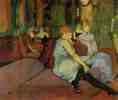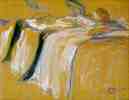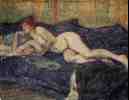![]()
Toulouse-Lautrec, Henri de (1864-1901). Many immortal painters lived and worked in Paris during the late 19th century. They included Degas, Cézanne, Gauguin, Van Gogh, Seurat, Renoir, and Toulouse-Lautrec. Toulouse-Lautrec observed and captured in his art the Parisian nightlife of the period.
Henri de Toulouse-Lautrec was born on Nov. 24, 1864, in Albi, France. He was an aristocrat, the son and heir of Comte Alphonse-Charles de Toulouse and last in line of a family that dated back a thousand years. Henri's father was rich, handsome, and eccentric. His mother was overly devoted to her only living child. Henri was weak and often sick. By the time he was 10 he had begun to draw and paint.
At 12 young Toulouse-Lautrec broke his left leg and at 14 his right leg. The bones failed to heal properly, and his legs stopped growing. He reached young adulthood with a body trunk of normal size but with abnormally short legs. He was only 1.5 meters tall.
Deprived of the kind of life that a normal body would have permitted, Toulouse-Lautrec lived wholly for his art. He stayed in the Montmartre section of Paris, the center of the cabaret entertainment and bohemian life that he loved to paint. Circuses, dance halls and nightclubs, racetracks--all these spectacles were set down on canvas or made into lithographs.
Toulouse-Lautrec was very much a part of all this activity. He would sit at a crowded nightclub table, laughing and drinking, and at the same time he would make swift sketches. The next morning in his studio he would expand the sketches into bright-colored paintings.
In order to become a part of the Montmartre life--as well as to protect himself against the crowd's ridicule of his appearance--Toulouse-Lautrec began to drink heavily. In the 1890s the drinking started to affect his health. He was confined to a sanatorium and to his mother's care at home, but he could not stay away from alcohol. Toulouse-Lautrec died on Sept. 9, 1901, at the family chateau of Malrome. Since then his paintings and posters--particularly the Moulin Rouge group--have been in great demand and bring high prices at auctions and art sales.
 Rosa La Rouge - À Montrouge
Rosa La Rouge - À Montrouge
1886-87; Oil on canvas, 72.3 x 49 cm;
Barnes Foundation, Merion, Pennsylvania
 Justine Dieuhl
Justine Dieuhl
c. 1891; 74 x 58 cm; Musée D'Orsay, Paris
 Moulin Rouge: La Goulue
Moulin Rouge: La Goulue
1891; Lithograph in four colors (poster), 191 x 117 cm;
Private collection
 La Goulue Arriving at the Moulin Rouge with Two Women
La Goulue Arriving at the Moulin Rouge with Two Women
1892; Oil on cardboard, 79.4 x 59 cm;
The Museum of Modern Art, New York
 At the Moulin Rouge: Two Women Waltzing
At the Moulin Rouge: Two Women Waltzing
1892; Oil on cardboard, 93 x 80 cm;
Narodni Galerie, Prague
 Ambassadeurs: Aristide Bruant
Ambassadeurs: Aristide Bruant
1892; Lithograph in six colors (poster), 141 x 98 cm;
Private collection
 Yvette Guilbert Greeting the Audience
Yvette Guilbert Greeting the Audience
1894; Oil over reproduction on photographic paper, 48 x 28 cm;
Musée Toulouse-Lautrec, Albi
 Woman Pulling up her Stocking
Woman Pulling up her Stocking
1894; Oil on cardboard, 58 x 48 cm;
Musée d'Orsay, Paris
 The Two Girlfriends
The Two Girlfriends
1894; Oil on cardboard, 48 x 34.5 cm;
Musée Toulouse-Lautrec, Albi
 Two Half-Naked Women Seen from behind in the Rue des Moulins Brothel
Two Half-Naked Women Seen from behind in the Rue des Moulins Brothel
1894; Oil on cardboard, 54 x 39 cm;
Musée Toulouse-Lautrec, Albi
 In the Salon of the Rue des Moulins
In the Salon of the Rue des Moulins
c. 1894; Oil on canvas, 111.5 x 132.5 cm;
Musée Toulouse-Lautrec, Albi
 Rue des Moulins: The Medical Inspection
Rue des Moulins: The Medical Inspection
1894; Oil on cardboard, 82 x 59.5 cm;
National Gallery of Art, Washington
 The Toilette
The Toilette
1896; 67 x 54 cm; Musée D'Orsay, Paris
 Alone
Alone
1896; Oil on board, 31 x 40 cm; Musée D'Orsay, Paris
 Reclining Nude
Reclining Nude
1897; Oil on wood panel, 12 x 15 1/2 in;
Barnes Foundation
Photographs by Charalambos Amvrosiou and Mark Harden.